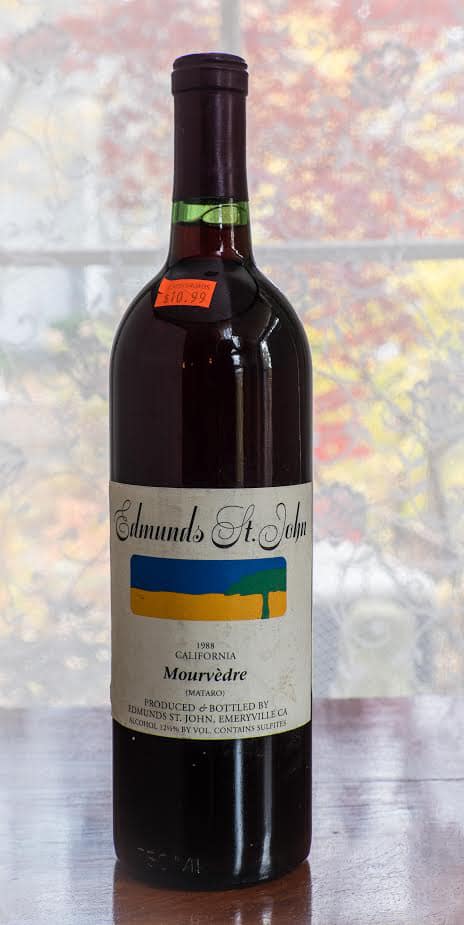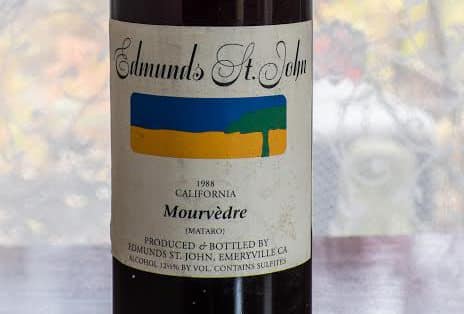I first drank Mourvèdre without knowing that I was drinking Mourvèdre.
Mourvèdre is a red wine grape most associated with the south of France but that came originally from Spain, where it is called Monastrell. (In the United States it is sometimes called Mataro, as it is secondarily on the label of this odd bottle.)
Mourvèdre is the roi cépage (king grape) in Bandol, which is the greatest red wine of Provence. As is said in Provence, “There are only two types of wine drinkers in the world: those who love the wines of Bandol, and those who don’t know the wines of Bandol.”
Provence is very hot and dry in the summer. That made it perfect for the growing of Mourvèdre, until about 1880 when a parasitic insect, Phylloxera vastatrix, possibly introduced on American vines, destroyed nearly all the vines in Provence (and in other parts of France even earlier).
But Mourvèdre to this day is, through its regenerated growth and use, honored in Bandol. And my first taste of the grape was in a fine wine from Bandol.
My wine merchant at the time, who was my first and most influential wine merchant, one day said to me, “You can’t afford Domaine Tempier. So try this Chateau de Pibarnon.” I couldn’t afford that either, but what else can you do when someone offers you a bargain except buy it (at least if it’s wine)?
It was a wonderful wine. I bought more of it, which is what wine collectors always do when it comes to “bargain” wines they can’t afford. And to confuse matters, the same wine merchant sold me on (and thus sold me) a fine Bordeaux red wine called Chateau Peyrabon. (To this day, as I sit here having to type out both names, I have often confused the names of those two wines.)
Chateau de Pibarnon (the Bandol) is 90 percent Mourvèdre (and 10 percent Grenache).
But I didn’t know that then. What I knew then about grapes in wine was what was on a wine’s label, and in France, wines only from Alsace are customarily labeled varietally.
Years later I was speaking (not, assuredly, about wine) at the Americade Motorcycle Rally in Lake George, New York. My sponsor there was Esquire magazine, and I let my Esquire host take me to dinner (you don’t have to work for a magazine to take me to dinner; just ask). She took me to a restaurant on a golf course. I thus let her let me break one of my rules: never eat dinner at a restaurant on a golf course.
She handed me the wine list, which is always less of a thrill than a terrible responsibility when someone else is paying. I saw on the list a reasonably priced wine that I had never tried (the wine or, I then believed, the grape) and that sounded enticing: Cline Cellars Ancient Vine Mourvèdre.
That wasn’t my first Mourvèdre (the Pibarnon was). But it was the first time I knew I was drinking Mourvèdre.
I remember nothing of that meal but the wine. I loved that wine. I loved it so much I returned the next night to the same restaurant on a golf course and ordered the same wine and that time I treated Esquire magazine on my imaginary expense account (partially provided by the IRS).
The vintage of that Cline Mourvèdre was 1995. By the time I ordered it (twice on the golf course, and then I bought six bottles of it when I got back home), I owned the odd bottle that is the subject of this piece: 1988 Edmunds St. John California Mourvèdre.
Like most of my odd bottles, this is the one bottle of the wine (in that vintage) that I bought. And so I kept it and kept it and could find no good excuse to open it until I realized that it had become, indeed, an odd bottle, worthy (I hoped) of writing about.
I had become interested in the southern-French style (meaning primarily with Rhone grapes) wines made by such iconoclastic

American rebels as Steve Edmunds (Berkeley, CA) and Sean Thackrey (Bolinas, CA). And so I purchased various single bottles of their wines, all in the 1980s and most of which I have not yet drunk.
Of Steve Edmunds himself you may read here, and here.
The cork put into the bottle some 25+ years ago came out easily, but it did break in two (thus preventing me from adding it to my collection of thousands of corks, which we hope one day to fashion into a chair like the incredibly expensive all-cork chair we saw in the window of a store on Abbot Kinney Boulevard in Venice, California).
The wine, poured, was pale from age (young, it is deeply purple), and pronouncedly brickish, like an old pinot noir from Beaune. But there the comparison ends.
The wine’s age was apparent on the nose, but it was a kind of sweetness of age.
In the mouth, it was both refreshing and challenging. Tannins were mostly resolved, but there was a distinct tartness that followed through on the swallowing of this impressively young-seeming, old-seeming wine.
The “animal” flavors (a polite way of saying “barnyard”), of which Jancis Robinson (among many others) writes, had, “developed into more beguiling leather and tar.” What’s interesting about this is that “leather and tar” are commonly used to describe the taste not only of Mourvèdre but also of wines made from Nebbiolo, Barolos in particular.
The one word I would best use to describe this Mourvèdre is vibrant. Not vibrant in the sense of vigorous, because the wine was too old for that. But vibrant in the sense of resonant, as if it were almost music in the mouth, keeping time with its own demise.
It did not, however, hold up to the spiciness of some of the sausage with which it was served. For that, we’d have been better off with a Syrah.
The next day, after the wine had been refrigerated overnight and then decanted (because there was a lot of visible sediment), it had lost most of its vibrancy and didn’t stand a chance against the leftover sausage.
We had drunk it on the best last day of its life (it may stay peculiarly youthful yet is not going to improve) but, as sometimes happens, not provided it with quite the right culinary accompaniment.
This wine cost $10.99 at Crossroads in New York in 1990. That’s the equivalent of about $21 today, and the wines Steve Edmunds makes and sells today are priced at not terribly much more than that (from the winery, where you’re most likely to find them). I don’t believe he makes a wine of 100% Mourvèdre. But he still does make wine from Mourvèdre.
Drink Mourvèdre. And unlike the young me, know what you’re drinking.
![]()
First published October 2016
